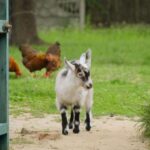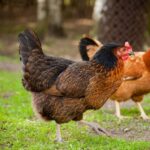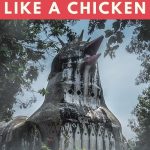If you’re looking for ways how to scare hawks away from your chickens, the best solutions are; covering their run, getting a guard dog, adding a rooster to your flock, using decoys, and some other tactics I discuss.
Hawks are very effective birds of prey and will kill a chicken before you have time to react. If you have any suspicions that there are hawks in your area, don’t leave it down to chance!
Here are some of the most effective ways to scare hawks away from your flock and ensure the safety of your chickens:
Table of Contents
How To Scare Hawks Away From Your Chickens
Add a Rooster To Your Flock
This isn’t going to be an option for everyone and a lot of people do not want to get a rooster - but it is one of the ways you can scare away hawks.
Or, at least have an added layer of protection if hawks are spotted. A rooster’s role within a flock is to protect the hens, so they’ll raise an alarm if they see any predators.
They will make a loud noise if they see a predator, which will notify you if you’re near, and of course, warn the hens to run for cover. They will also be aggressive and fight to protect hens, although that’s going to be a losing battle vs a hawk in most instances.
Cover Their Run and Limit Free-Ranging
Obviously, hawks are ariel predators. They are going to swoop down and attack a chicken, not sneak up and find a way into their coop or run like a raccoon or possum.
This means that whenever your chickens are roaming in the open or don’t have a roof over their heads, they are potentially in danger.
So, while chickens are much happier being free-range if there is a risk of hawks you need to keep them in their run. Said run also needs to be a strong roof on it to keep hawks out!
Related - Should a chicken run have a roof on it?
Don't Leave Feeders Outside
There are two reasons why leaving feeders outside of the coop or an enclosed run is a bad idea;
The first is that generally speaking, food attracts predators. While chicken feed might not be high up on a hawk’s list of priorities, it will attract rodents - and rodents are likely to pique a hawk’s interest.
The second reason is that when chickens are huddled around a feeder with their heads down concentrating on eating, they’re much more vulnerable to a hawk attack.
Keep all food safely secured under a roof and out of the sight of any other animals. It’s always for the best.
Use Decoys
There are various decoys designed to scare away hawks, and many other predators for that matter.
I’ve looked into this in great detail, and always seem to find mixed reviews/results. I’ve not actually tested it myself, so I can’t tell you from experience it worked for me.
I always see it recommended though, so I have to bring it to your attention. The best decoy to scare or deter hawks is an owl. Owls are natural enemies to hawks, and apparently, hawks are pretty scared of them.
Here is one of the highest-rated owl decoys on Amazon designed to scare away hawks, for example:

It’s one of the simplest and least invasive ways to deal with hawks, so it’s worth a try. And let’s be honest, those large solar-powered eyes do look a little scary!
Use Noisey Deterrents
Noisey deterrents are one of the age-old hacks to scare away all types of birds. I’ve read accounts from farmers that have had decent success with noise vs hawks, in particular.
For homemade solutions, the most common way to create a noisy deterrent is by hanging some CDs or DVDs on a piece of string and letting them clack together in the wind. (It’s the best use for old CDs in my opinion).
For shop-bought solutions, you could use wind chimes or some other items that bang, crash, and smash together in the wind.
The main issue with this method is that, well, it’s noisy. If you have neighbors, they’re not going to appreciate the sound of wind chimes and old CDs clacking together, that’s for sure.
Neither are you if it’s within your earshot. Plus, you need wind for most of these to make a noise.
Use Flashy Deterrents
Flashy or reflective objects have also been used for many years to deter all types of birds from going near crops, animals, and other areas.
You can buy some pretty interesting devices, or you can simply use some reflective tape! That’s what I’ve used before, and it works a treat.
Something like this tape on Amazon should do the trick:
Adhesive Bird Scare Holographic Flash Tape

It’s probably more effective at deterring hawks from hanging out or targeting specific areas than it is at keeping them from entering a large space though, do keep that in mind.
It’s always a good idea to read some of the reviews and direct any questions you have to the
Related FAQs
Will Owl Decoy Keep Hawks Away?
This question comes up a lot, and I understand why. You don’t want to position a big owl statue in your yard if it’s not going to work. Not least because by time you know it’s not working you may have lost a chicken.
The problem is that owl decoys are not 100% guaranteed. Few methods are. The best you can do is read some reviews, and possibly try one out while your chickens are safe inside an enclosed run.
See if it scares or deters hawks when they’re not able to actually get at your chickens first.
Will a Hawk Keep Coming Back for Chickens?
Hawks are likely to come back if they successfully take a chicken away, yes. It’s normal for most animals, especially those looking for prey, to stick around where they find a food source.
This is why it’s best you go over the top when defending your property and scaring away hawks.
Can I Shoot a Hawk Attacking My Chickens?
No! Hawks are listed on the Migratory Bird Treaty Act Protected Species (10.13 List) and are a protected species.
No matter how big of a nuisance they are, you cannot legally shoot them. Neither can you trap, hunt, or hurt them in any way.
If they’re becoming a problem and you can’t stop them from attacking your chickens using the methods covered in this article, contact your local government office and ask for advice.
In Summary
I’ve covered six of the most effective ways chicken keepers protect their flocks and how they scare hawks away. I’m sure you will be able to use one or more of these methods in combination to keep your flock safe!
Resources
Image credits - Header photo by Lauren Marmor on Unsplash
Hawks and Owls - USDA APHIS
Migratory Bird Treaty Act Protected Species - U.S. Fish & Wildlife Service




